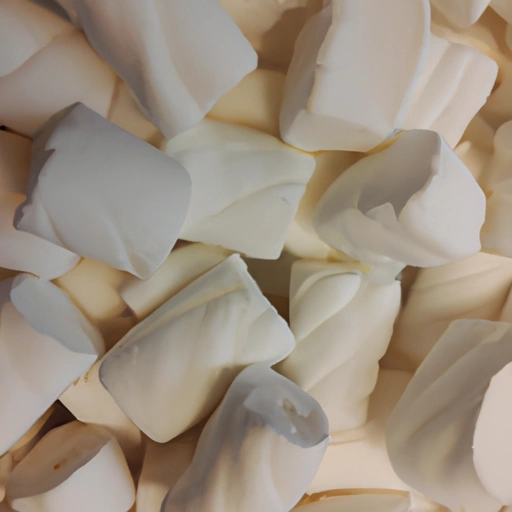Marshmallow
Description

Marshmallow is a type of confectionery that is typically made from sugar, water, and gelatin, which is whipped to a spongy consistency and coated with powdered sugar. In modern usage, the term 'marshmallow' often refers to the fluffy, pillow-like treats that are popular in the United States and around the world. They come in various sizes from small, bite-sized pieces to large blocks and are a favorite ingredient in a wide range of desserts and sweet dishes.
Common uses
Marshmallows are incredibly versatile and can be used in a variety of culinary applications. They are commonly melted into hot beverages, such as hot chocolate, to add a creamy and sweet element. Marshmallows are also a key ingredient in the classic American S'mores, where they are sandwiched between graham crackers with a piece of chocolate and roasted over a fire. Additionally, they are used as a topping for sweet potato casseroles, melted into fudge and rice cereal treats, or simply eaten as a sweet snack.
Nutritional value
Calories
A standard serving of marshmallows, which can be about 4 large or 1 ounce (28 grams / approx. 30 mL), contains roughly 90 to 100 calories.
Protein
Marshmallows contain a minimal amount of protein, with a typical serving providing less than 1 gram.
Fat
Marshmallows are virtually fat-free, with a standard serving containing less than 0.1 grams of fat.
Carbohydrates
The primary macronutrient in marshmallows is carbohydrates, with a serving size containing about 22 to 24 grams, mostly in the form of sugars.
Vitamins
Marshmallows do not provide significant amounts of vitamins.
Minerals
Marshmallows are not a notable source of minerals and have only trace amounts.
Health benefits
Marshmallows are largely considered a treat rather than a health food. Due to their high sugar content and lack of essential nutrients, their health benefits are minimal. However, some people use marshmallow root extract, which is different from the confection, for its potential anti-inflammatory properties and to soothe coughs and colds.
Potential risks
Consuming marshmallows in excess can lead to an increase in dietary sugars and may contribute to weight gain, dental problems, and potential issues with blood sugar regulation. As with any high-sugar food, they should be consumed in moderation, especially by individuals with pre-existing health conditions such as diabetes.
Common recipes
Marshmallows are a staple in many recipes, including Rocky Road, S'mores, marshmallow-topped sweet potato casseroles, rice cereal treats, and homemade candies like marshmallow fondant.
Cooking methods
Marshmallows are often melted or toasted. They can be melted in a double boiler, microwave, or gently over a stove. Toasting marshmallows is popular over an open flame, giving them a caramelized outer layer with a gooey center.
Pairing with other ingredients
Marshmallows pair well with chocolate, graham crackers, peanut butter, various fruits like bananas and strawberries, and are often found in desserts with a creamy or rich texture.
Summary
Marshmallows are a popular confection known for their soft, spongy texture and sweet taste. While they offer little in nutritional value, they are a beloved treat in many cultures and can be used in a multitude of recipes that range from hot drinks to complex desserts. Although they should be enjoyed in moderation, marshmallows continue to be a versatile and enjoyable ingredient in the culinary world.